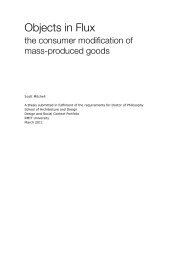Making Memory Space: Recollection and Reconciliation in Post ...
Making Memory Space: Recollection and Reconciliation in Post ...
Making Memory Space: Recollection and Reconciliation in Post ...
Create successful ePaper yourself
Turn your PDF publications into a flip-book with our unique Google optimized e-Paper software.
Site, space <strong>and</strong> architecture can wordlessly convey the realities of a regime. As Nick Sheppard <strong>and</strong><br />
Noelene Murray write,<br />
We view cities as sites of memory <strong>and</strong> desire (<strong>and</strong> also fear <strong>and</strong> forgett<strong>in</strong>g); as contested<br />
spaces given to plays of power <strong>and</strong> privilege, identity <strong>and</strong> difference; as palimpsests of<br />
historical experience, <strong>in</strong> which underly<strong>in</strong>g strata disconcert<strong>in</strong>gly erupt <strong>in</strong>to those above;<br />
<strong>and</strong> as lived spaces <strong>in</strong> the everyday performance of urban life. 61<br />
Official totems of the past, sanctioned structures that convey a specific narrative operate with<strong>in</strong> the<br />
context of the city, where placement, sit<strong>in</strong>g <strong>and</strong> production all contribute to the significance or power of<br />
their narrative. The relationship of these totems to the city <strong>and</strong> the city’s relationship to the past are<br />
vital <strong>in</strong> determ<strong>in</strong><strong>in</strong>g the nature of their narrative <strong>and</strong> <strong>in</strong> acknowledg<strong>in</strong>g the state of memory that they<br />
produce. Thus a brief exam<strong>in</strong>ation of the relationship between memory <strong>and</strong> the city assists <strong>in</strong> locat<strong>in</strong>g<br />
the specific dialogue around officially-sanctioned memory space <strong>and</strong> the city itself.<br />
Lewis Mumford identifies the city as simultaneously a site of endurance <strong>and</strong> transformation. He<br />
presents the urbanscape as a palimpsest of mean<strong>in</strong>g to be revealed <strong>and</strong> concealed accord<strong>in</strong>g to<br />
different viewpo<strong>in</strong>ts. 62 Mumford argues that the city operates as a repository for human recollection, a<br />
physical manifestation of the past. The role that physical form plays <strong>in</strong> recollection contributes to the<br />
emotive environment of the city <strong>and</strong> which assists <strong>in</strong> generat<strong>in</strong>g the unique identity of each one. Local<br />
<strong>and</strong> national identity are largely constructed <strong>and</strong> ma<strong>in</strong>ta<strong>in</strong>ed through the built form of the city<br />
environment that generates a specificity of ‘place’ based on the relationship between physical form<br />
<strong>and</strong> the narratives that exist around the events that occurred there. Eric S<strong>and</strong>weiss suggests that the<br />
def<strong>in</strong>itions of self <strong>and</strong> statehood are not r<strong>and</strong>om but are the result of a human compulsion to add a<br />
level of explicit mean<strong>in</strong>g through the construction of sites of unchang<strong>in</strong>g memory to the fluidity of the<br />
city. 63 In this respect the human desire to memorialise aspects of the city occurs as a means of<br />
preserv<strong>in</strong>g the past. The city may operate as a liv<strong>in</strong>g repository for human experience, <strong>and</strong> yet as a<br />
liv<strong>in</strong>g entity it is susceptible to change. Consequently the need to exercise the memorialis<strong>in</strong>g impulse<br />
of architecture emerges with<strong>in</strong> that environment, to generate unchang<strong>in</strong>g markers <strong>in</strong> the l<strong>and</strong>scape of<br />
time – a visual timel<strong>in</strong>e - which assist <strong>in</strong> perpetuat<strong>in</strong>g long-held recollections of past experiences. This<br />
desire to protect aspects of the city from the <strong>in</strong>evitable destruction of time parallels the role of the<br />
museum, namely to operate as repository for cultural objects held steady <strong>in</strong> a constantly shift<strong>in</strong>g<br />
context. 64<br />
61<br />
Noeleen Murray, Nick Shepherd, <strong>and</strong> Mart<strong>in</strong> Hall (eds.), Desire L<strong>in</strong>es, <strong>Space</strong>, <strong>Memory</strong> <strong>and</strong> Identity <strong>in</strong> the <strong>Post</strong> Apartheid City,<br />
(Oxon: Routledge, 2007), p.1.<br />
62<br />
Lewis Mumford, The City <strong>in</strong> History: Its Orig<strong>in</strong>s, Its transformations, <strong>and</strong> Its Prospects (New York: Harcourt, Brace <strong>and</strong> World,<br />
1961), p.569.<br />
63 Eric S<strong>and</strong>weiss, Op cit, p.26.<br />
64 Ibid.<br />
26
















